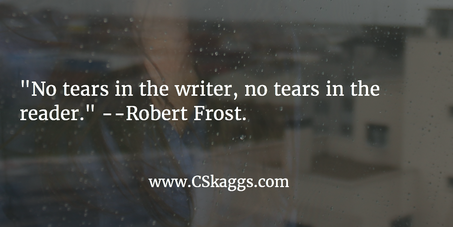February 2016 Workshop Frost had a valid point. Emotion originates within the writer. The most efficient—although not the easiest—method to achieve authentic emotions in writing is familiarity with your own emotions. The writer must be open to exposing his emotions in order to elicit them in the reader. Write what you know very specifically applies to emotions. If a writer can’t or won’t expose a raw nerve, the narrative could read as disconnected. If the writer isn’t feeling the adrenaline rush of an action scene, or the heartbreak of a tragedy, it is unlikely the reader will feel those emotions. It’s important to remember that when we’re scared, we’re rarely thinking: “I’m freaking out here.” We are experiencing emotions in real time, within our own skin. What are your symptoms for fear, anger, sadness, or depression? Use those “symptoms” to show the reader the emotions of the character. You might never have experienced being chased through the streets of Amsterdam by a crazed killer, but you have been scared. You know the symptoms. You can imagine the fear and the rush and the panic (or lack thereof). Live the scene and the reader will as well. In the Bourne books, for example, the reader feels the time crunch, the action, the adrenaline of the main character. Robert Ludlum doesn’t spend pages of narrative telling the reader. The reader experiences the story through Bourne. It’s fast-paced, and while not overly emotional or melodramatic, the reader has a visceral experience through Bourne. We recognize anger and revenge and self-preservation without the author telling us that the character feels those things. To a certain extent, the amount of emotion you include in your writing is governed by your genre and your character. Character: There is a balance between not enough and too much emotion in a novel. I recently read a book by a NYT bestselling author. In a later chapter, a male character spends six to eight pages “telling” another character his emotions. As a female, if my best friend goes on for the equivalent of six to eight pages, I’ll make appropriate noises of compassion, but by the sixth page, I’m ready to suggest therapy. If a male friend went on for six pages, I’d have to swallow my tongue to keep from telling him to man up. Conversely, characters who feel too little on the page come across as emotionally stunted. My characters rarely have their personal shiz together. I like them a little off balance, but I run a fine line between creating characters that are emotionally reserved and presenting a character that the reader can not relate to. I have a novel that I cannot sell for the life of me, because the editor/agent doesn’t like the main character. I absolutely adore her. She’s broken and numb and emotionally jacked, but if I don’t show enough emotion at the outset, in order for the reader to connect, that book will stay on my hard drive. Your characters need to behave in a way that is authentic to their gender and their persona. Genre: I cannot express this enough. You need to know your genre. Read extensively across the line to see the level of emotion present in the genre you want to publish. Thrillers spend a lot less time on emotional details than a romance. Where’s the line? Read, read, read. There is no substitute. Stephen King has said, “If you don't have time to read, you don't have the time (or the tools) to write. Simple as that.” Now to specifics. The best novels present emotional details in much the same way we do setting. 1) Reveal emotion through body language. Body language is something a writer should study. People-watching is a valid writing activity. Let the movement of the character through the scene suggest an emotion that you don’t specifically name. The reader may interpret the body language differently than the writer intends, but that’s okay. The same happens in real life when one person recognizes depression while another assumes apathy. The reader brings their observations and experiences to the story. The Emotion Thesaurus is a good place to start for specific movements related to different emotions. As the character moves through the scene, have him notice little details. The witness’s hand is icy cold, despite her calm demeanor. The suspect’s flirtatious laughter is high and false. The guy at the table keeps looking at the door. Is he waiting for someone or searching for a quick exit? Let the character experience and witness details organically in the story. Like setting, emotions shouldn’t be dropped into the scene in a large info dump. Drop nuggets into the active scene as the character encounters it. That way, the reader doesn’t skip around or get bored. 2) Reveal emotion through a character's level of experience. A hardened detective will notice signs of avoidance or outright lying by a suspect, but he’s probably not what we’d call emotionally sensitive. Not cruel, but he’s probably not going to be moved by a witnesses tears. If he spends six pages of narration talking about how lonely he is, we are going to do the equivalent of telling him to man up. We’re tossing that book aside. A victim, on the other hand, probably won’t notice the lying, except in hindsight, perhaps. Instead, the victim experiences the shock of betrayal. How does that look or feel? If you’ve been betrayed or lied to or cheated on, you know how that feels. Describe the symptoms not the emotion. 3) Reveal emotion through the mood of the story. As the article on setting Four Ways to Bring Setting to Life expressed: “Filtering a scene through a character's feelings can profoundly influence what the reader sees.” Word choice is key to setting the mood and emotion of the story. 4) Reveal emotions through the senses. Smell pulls memory from a character. They’re walking down the street and smell pizza from the nearby pizzeria and are reminded of their first breakup. They pass an alley and smell urine and rotting garbage. They pass a florist and remember their grandfather’s funeral. You don’t have to tell us the mood (emotion) of these characters, because the details the character notices do that for us. Remember from our lesson last month:
ApplicationTo focus on emotion in a scene, ask yourself these questions:
Look at the following pictures. What emotions do you see reflected in the image? Does it matter what genre you’re writing? Your character? NOW, ask the ten questions above, and write a short segment (approx 100 words) to evoke that emotion based on the photo of your choice. Feel free to post your writing prompt in the comments below! Read more:This is exactly what we were talking about last Thursday! I found it here. I find it fascinating what other writers think on the same topic...nearly simultaneously. Very cool. Anyway, best line for me on The Importance of Writing from the Heart by Scott D Southward: "Heart is the one thing that truly can’t be taught in an English or writing classroom, but it is also the most important thing a writer will need. And if used right by a writer, it can change opinions, stir a reader to act, and even make people cry or laugh. It is what takes a jumble of words and turns them into a message." We have to be willing to take risks and expose our mangled heart when we write! Enjoy the article. :)
1 Comment
|
AuthorWriter, college professor, lover of story, fan of all things bookish. Plus chocolate, because who doesn't love chocolate. Archives
August 2019
Categories
All
|



 RSS Feed
RSS Feed